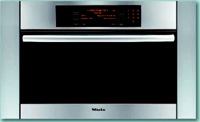Not surprisingly, many successful and busy custom home owners don’t cook as frequently as they would like. When they do manage to cook for family and friends time is still of the essence—but they aren’t willing to sacrifice the quality of their food just to get it on the table faster. Speed-cooking ovens can be a valuable addition to the usual arsenal of high-end appliances because they offer a time-saving solution that also promises to deliver quality cooking results.
While they are not a new concept, several new models combining different technologies are designed to accommodate the needs of the everyday cook and the entertainer alike. Over the past five years people have started to move back toward cooking at home rather than eating out, according to Steve Beshara, chief branding officer for TurboChef. Using a speed oven at home “frees up people to live more of their lives instead of waiting on an appliance,” Beshara says.
Some speed ovens on the market combine standard convection heat and microwaves, while a few use a halogen- or quartz-light heat source combined with microwaves. Others combine radiant, convection, and microwaves; and at least two models use a commercial air impingement system that forces hot air through jets at high speeds into the oven cavity, assisted by microwaves.
Maintaining cooking quality at fast speeds requires locking in moisture and caramelizing the food’s exterior, according to manufacturers, and regardless of the technologies used all speed ovens aim to achieve both goals. For most items, the primary heat sources sear the food’s exterior to create a caramelized crust that seals in moisture while microwaves help cook the food more quickly from the inside out.
“In addition to time savings, consumers often find that their food comes out more tender and moist than when cooked in a conventional oven. Less time exposed to hot dry air often means that more moisture can be retained in the food,” points out Allison Eckelcamp, public relations program manager for GE Appliances.
Most speed oven controls feature programs that automatically choose the optimal combination of cooking modes to use for a given food item, setting the microwave level and duration, air temperature, and time. Although control panels walk the user through the steps to set cooking functions, there is a learning curve. “When convection ovens first came on the scene, it was difficult for people to adjust their cooking habits. The same adaptations will have to happen here,” says Matthew Kueny, head of Miele product development.
Cooking times are automatically converted from standard to speed settings, and several speed oven models have pre-programmed menus built into the control system as well. Some programs even let the cook save favorite recipe settings and set cook modes manually.



